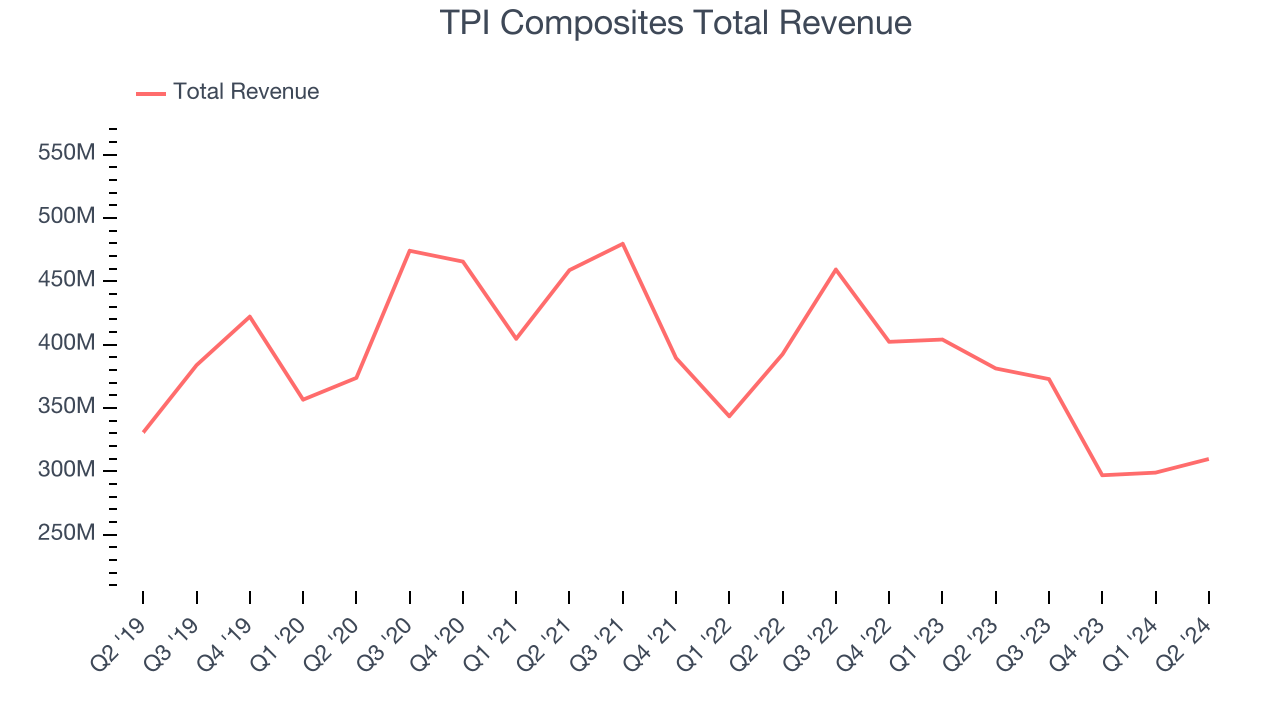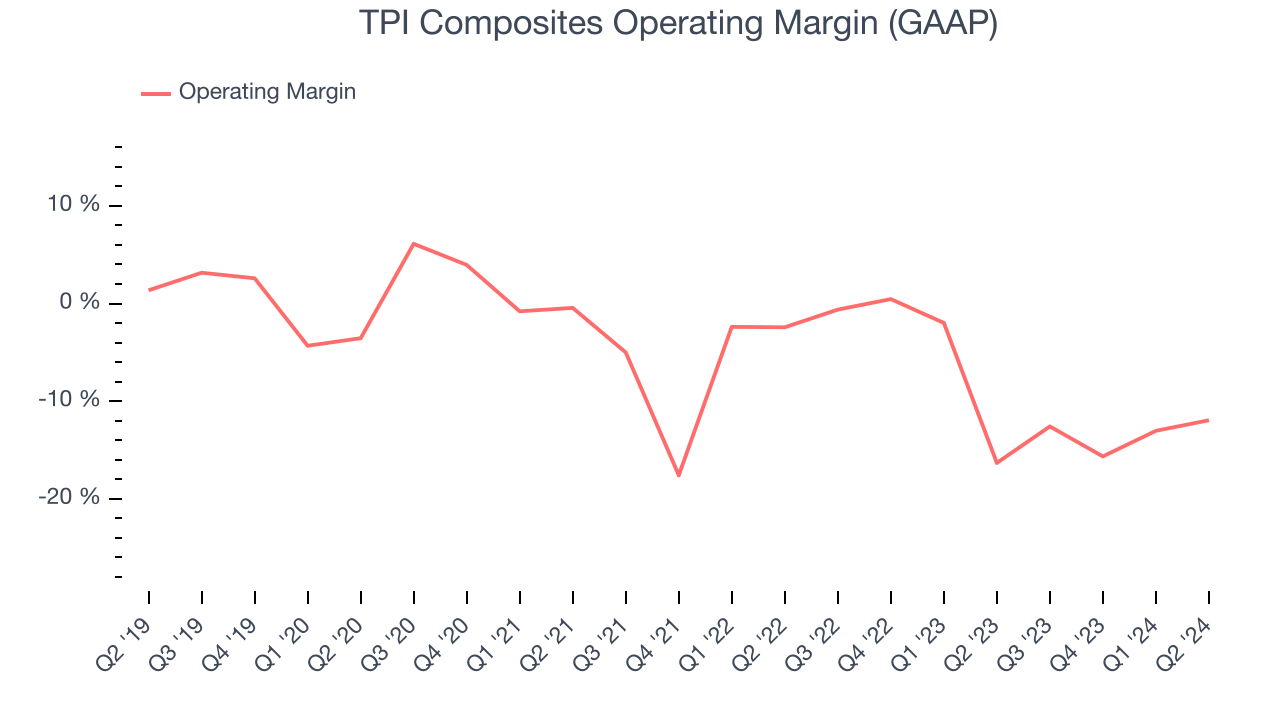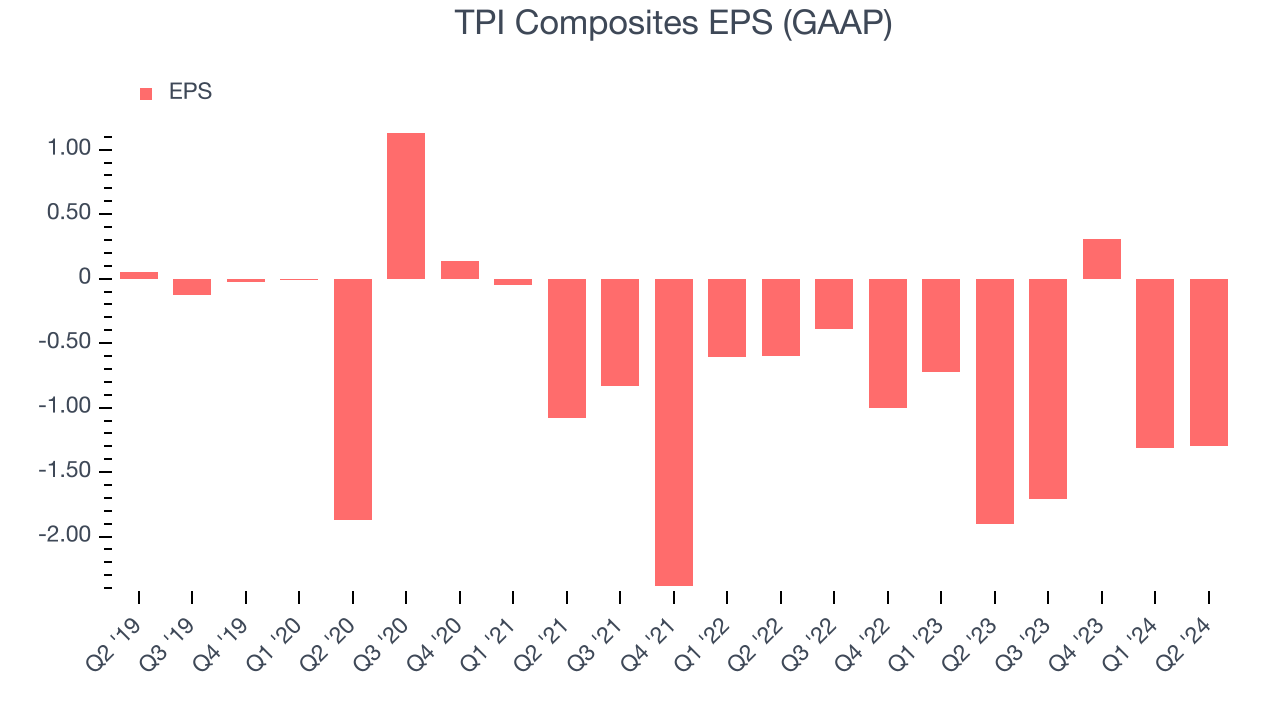General contracting company Tutor Perini (NYSE:TPC) reported results in line with analysts' expectations in Q2 CY2024, with revenue down 18.7% year on year to $309.8 million. The company's outlook for the full year was also close to analysts' estimates with revenue guided to $1.35 billion at the midpoint. It made a GAAP loss of $1.30 per share, improving from its loss of $1.90 per share in the same quarter last year.
Is now the time to buy TPI Composites? Find out by accessing our full research report, it's free.
TPI Composites (TPIC) Q2 CY2024 Highlights:
- Revenue: $309.8 million vs analyst estimates of $309.8 million (small beat)
- Adj EBITDA: -$24.9 million vs analyst estimates of -$8.8 million (miss)
- The company reconfirmed its revenue guidance for the full year of $1.35 billion at the midpoint
- Gross Margin (GAAP): -1.2%, up from -11.5% in the same quarter last year
- EBITDA Margin: -8%, up from -10.2% in the same quarter last year
- Free Cash Flow was -$44.02 million compared to -$47.29 million in the previous quarter
- Market Capitalization: $155 million
“In the second quarter we were able to complete the divestiture of our Automotive business and we closed the Nordex Matamoros plant for Nordex, two loss making businesses that have negatively impacted TPI’s performance. We also continued the ramp of ten lines either in startup or transition. As these lines enter serial production and utilization increases, combined with the divestiture of the Automotive business and shut down of the Nordex Matamoros plant, we are positioned to return the company to profitability and positive free cash flow in the second half of the year,” said Bill Siwek, President and CEO of TPI Composites.
Known for constructing the Philadelphia Eagles’ Stadium, Tutor Perini (NYSE:TPC) is a civil and building construction company offering diversified general contracting and design-build services.
Renewable Energy
Renewable energy companies are buoyed by the secular trend of green energy that is upending traditional power generation. Those who innovate and evolve with this dynamic market can win share while those who continue to rely on legacy technologies can see diminishing demand, which includes headwinds from increasing regulation against “dirty” energy. Additionally, these companies are at the whim of economic cycles, as interest rates can impact the willingness to invest in renewable energy projects.
Sales Growth
Examining a company's long-term performance can provide clues about its business quality. Any business can put up a good quarter or two, but the best consistently grow over the long haul. Unfortunately, TPI Composites's 1.7% annualized revenue growth over the last five years was weak. This shows it failed to expand in any major way and is a rough starting point for our analysis. 
Long-term growth is the most important, but within industrials, a half-decade historical view may miss new industry trends or demand cycles. TPI Composites's history shows it grew in the past but relinquished its gains over the last two years, as its revenue fell by 10.7% annually.
This quarter, TPI Composites reported a rather uninspiring 18.7% year-on-year revenue decline to $309.8 million of revenue, in line with Wall Street's estimates. Looking ahead, Wall Street expects sales to grow 19.9% over the next 12 months, an acceleration from this quarter.
Unless you’ve been living under a rock, it should be obvious by now that generative AI is going to have a huge impact on how large corporations do business. While Nvidia and AMD are trading close to all-time highs, we prefer a lesser-known (but still profitable) semiconductor stock benefitting from the rise of AI. Click here to access our free report on our favorite semiconductor growth story.
Operating Margin
Unprofitable industrials companies require extra attention because they could get caught swimming naked if the tide goes out. It's hard to trust that TPI Composites can endure a full cycle as its high expenses have contributed to an average operating margin of negative 4% over the last five years. This result isn't too surprising given its low gross margin as a starting point.
Analyzing the trend in its profitability, TPI Composites's annual operating margin decreased by 12.9 percentage points over the last five years. The company's performance was poor no matter how you look at it. It shows operating expenses were rising and it couldn't pass those costs onto its customers.

In Q2, TPI Composites generated an operating profit margin of negative 11.9%, up 4.4 percentage points year on year. Since its gross margin expanded more than its operating margin, we can infer that leverage on its cost of sales was the primary driver behind the recently higher efficiency.
EPS
We track the long-term growth in earnings per share (EPS) for the same reason as long-term revenue growth. Compared to revenue, however, EPS highlights whether a company's growth was profitable.
TPI Composites's earnings losses deepened over the last five years as its EPS dropped 69.2% annually. We tend to steer our readers away from companies with falling EPS, where diminishing earnings could imply changing secular trends and preferences. If the tide turns unexpectedly, TPI Composites's low margin of safety could leave its stock price susceptible to large downswings.

In Q2, TPI Composites reported EPS at negative $1.30, up from negative $1.90 in the same quarter last year. Despite growing year on year, this print missed analysts' estimates. Over the next 12 months, Wall Street is optimistic. Analysts are projecting TPI Composites's EPS of negative $4.01 in the last year to reach break even.
Key Takeaways from TPI Composites's Q2 Results
It was good to see TPI Composites's beat on revenue. Full-year revenue forecast beat analysts' expectations, which was another positive. On the other hand, its adjusted EBITDA missed. The quarter was mixed. The stock traded up 4.4% to $3.59 immediately following the results.
So should you invest in TPI Composites right now? When making that decision, it's important to consider its valuation, business qualities, as well as what has happened in the latest quarter. We cover that in our actionable full research report which you can read here, it's free.
